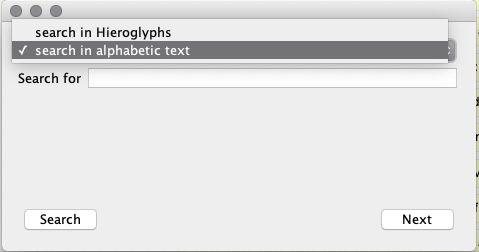Table of Contents
Searching Texts
Since JSesh version 7.2, it's possible to search in JSesh document (it was about time!).
It's possible to search either in the current document or in all the JSesh documents contained in a given folder.
Searching in the current document
To Search in the current document, you can use the menu entries:
- Edit/Find to open the “Find” dialog
- Edit/Find Next to search for the next occurrence of a search.

You then need to describe what you want to search. JSesh is quite powerful here. You can both search for hieroglyphic and non-hieroglyphic text.
By default, the search will look for corresponding sequences of signs, regardless of their layout. If you want to search for a specific layout, check the “Whole Quadrant Match” box.
Searching for Hieroglyphic Text
Searching for hieroglyphic text can be quite simple. Type the text you are looking for in the search field (see picture below), and press the “search” button.

By default, the search will look for sequences of signs, regardless of their layout. If you want to search for a specific layout, check the Whole Quadrant Match box.
Advanced Search for Hieroglyphic Text
You will notice a number buttons below the text field. They allow you to include more variability in the text you are looking for.
The "*" wildcard
The “*” button allows you to search for sequences of non-strictly consecutive signs. For instance, 𓁹“*”𓏏 will search for sequences of signs containing 𓁹, then possibly a number of other signs, then 𓏏.

As the search will find any corresponding sequence of signs, regardless of its length, you may end up with unexpected results - matching a 𓁹 in the second line of your text, and a 𓏏 in the fiftieth. To avoid this, you can limit the length of the expected result. For instance, if you want to allow at most two signs between 𓁹 and 𓏏, you may limit the result length to four signs, as is done in the example above, using the Max match length field.
A search string can contain multiple “*” if you want.
If Max match length is 0, it will be understood as “no limit”.
note: the “*” wildcard has nothing to do with the Manuel de Codage code “*” for grouping signs.
The "[...]" button
This buttons allows you to introduce variation in the signs you want to find. The system will search for any one of the signs between the […].
For instance, “𓊪[𓏲𓅱]” will search both for 𓊪𓏲 and for 𓊪𓅱.
Variants in searches
If you select “Extended variants”, search result will include texts which contain any variant of your signs as recorded in JSesh.
As 𓏲 and 𓅱 are considered as variants, the following search will find occurrences of both 𓊪𓏲 and 𓊪𓅱.
Compared to the use of […], this system is less precise ([…] allows you to specify exactly what you are looking for). It might be more exhaustive in some cases. It's however dependent on the quality of JSesh sign descriptions. The current information about variant is still very lacunar - sign descriptions require a lot of work.

Any kind of recorded variants will be used, as well as variants of variants. It is expected that a more precise system will be implemented at some point.
Search in non-hieroglyphic texts
Search is no longer restricted to the hieroglyphs. If you have typed translation or transliterations, you can search them too…
Select search in alphabetic texts…

Then type your text (search will disregard case) :

Search in folders
This is a very powerful feature of JSesh : it can search in all the glyph files contained in a folder (and its sub-folders). In a way, you can use your texts (including translations typed in JSesh) as a kind of rough linguistic database.
To use this function, use the menu Edit/Find in Folder. Then select the “root” folder for your search. In the example below, I'm looking for attestation of Atum, using a fairly generic wildcard. Note the use of […] to include variant signs (some possible determinatives are however missing in this search, I leave it to the interested reader as an exercice). Also note the length I have set to limit the false positive results. Remember that this length includes the whole result, not only the part skipped over by the “*”.

Once the search is started, the occurrences will appear in the list below the search form. Double-clicking on an occurrence will open the corresponding document.